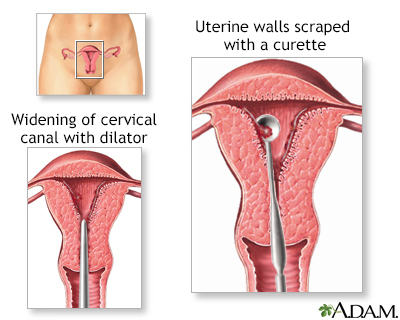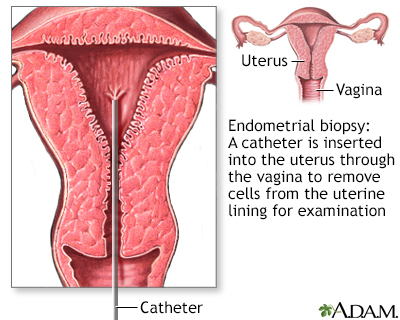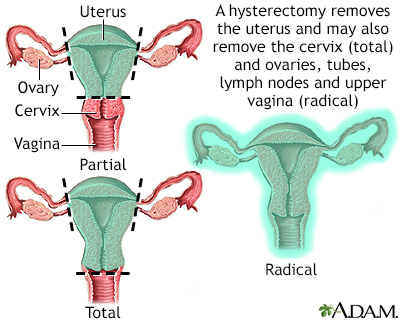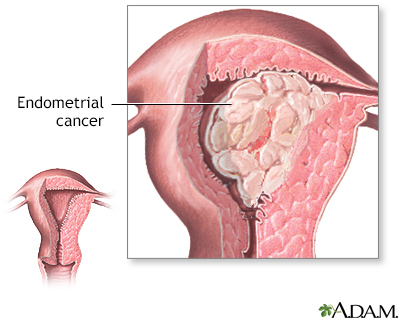National Breastfeeding Month: New recommendations from AAP
August is National Breastfeeding Month, an annual opportunity to bring attention to initiatives in our community that promote best practices for optimal health…

Update your location to show providers, locations, and services closest to you.
Endometrial cancer is cancer that starts in the endometrium, the lining of the uterus (womb).
Endometrial adenocarcinoma; Uterine adenocarcinoma; Uterine cancer; Adenocarcinoma - endometrium; Adenocarcinoma - uterus; Cancer - uterine; Cancer - endometrial; Uterine corpus cancer
Endometrial cancer is the most common type of uterine cancer. The exact cause of endometrial cancer is not known. An increased level of estrogen hormone may play a role. This stimulates the buildup of the lining of the uterus. This can lead to abnormal overgrowth of the endometrium and cancer.
Most cases of endometrial cancer occur between the ages of 60 and 70. A few cases may occur before age 40.
The following factors related to your hormones increase your risk for endometrial cancer:
Women with the following conditions also seem to be at a higher risk for endometrial cancer:
Symptoms of endometrial cancer include:
During the early stages of disease, a pelvic exam is often normal.
Based on your symptoms and other findings, other tests may be needed. Some can be done in your health care provider's office. Others may be done at a hospital or surgical center:
If cancer is found, imaging tests may be done to see if the cancer has spread to other parts of the body. This is called staging.
Stages of endometrial cancer are:
Cancer is also described as grade 1, 2, or 3. Grade 1 is the least aggressive, and grade 3 is the most aggressive. Aggressive means that the cancer grows and spreads quickly.
Treatment options include:
Surgery to remove the uterus (hysterectomy) may be done in women with early stage 1 cancer. The doctor may also remove the tubes and ovaries.
Surgery combined with radiation therapy is another treatment option. It is often used for women with:
Chemotherapy or hormonal therapy may be considered in some cases, most often for those with stage 3 and 4 disease.
You can ease the stress of illness by joining a cancer support group. Sharing with others who have common experiences and problems can help you not feel alone.
Endometrial cancer is usually diagnosed at an early stage.
If the cancer has not spread, 95% of women are alive after 5 years. If the cancer has spread to distant organs, about 25% of women are still alive after 5 years.
Complications may include any of the following:
Contact your provider for an appointment if you have any of the following:
There is no effective screening test for endometrial (uterine) cancer.
Women with risk factors for endometrial cancer should be followed closely by their doctors. This includes women who are taking:
Frequent pelvic exams, Pap smears, vaginal ultrasounds, and endometrial biopsy may be considered in some cases.
The risk for endometrial cancer is reduced by:







Armstrong DK. Gynecologic cancers. In: Goldman L, Schafer AI, eds. Goldman-Cecil Medicine. 26th ed. Philadelphia, PA: Elsevier; 2020:chap 189.
Boggess JF, Kilgore JE, Tran A-Q. Uterine cancer. In: Niederhuber JE, Armitage JO, Kastan MB, Doroshow JH, Tepper JE, eds. Abeloff's Clinical Oncology. 6th ed. Philadelphia, PA: Elsevier; 2020:chap 85.
Morice P, Leary A, Creutzberg C, Abu-Rustum N, Darai E. Endometrial cancer. Lancet. 2016;387(10023):1094-1108. PMID: 26354523 pubmed.ncbi.nlm.nih.gov/26354523/.
National Cancer Institute website. Endometrial cancer treatment (PDQ)-health professional version. www.cancer.gov/types/uterine/hp/endometrial-treatment-pdq. Updated February 24, 2022. Accessed April 11, 2022.
National Comprehensive Cancer Network website. NCCN guidelines for patients: uterine cancer, endometrial carcinoma, uterine sarcoma. Version 3.2021. www.nccn.org/patients/guidelines/content/PDF/uterine-patient.pdf. Updated June 3, 2021. Accessed April 11, 2022.



Our community and patient programs provide great value to patients, families and loved ones. People can find support, educational materials, expert consultants and more. In most instances, these programs are offered free of charge.
Improves health and quality of life for long-term cancer survivors.
An educational and networking event that brings together cancer patients, survivors, caregivers and health care professionals.
Helps individuals access high-quality cancer screening, prevention and treatment services.
Can assist you through the treatment process in a number of practical and supportive ways.
August is National Breastfeeding Month, an annual opportunity to bring attention to initiatives in our community that promote best practices for optimal health…

The United States Congress designated January as Cervical Health Awareness Month. Almost 13,000 women in the United States are diagnosed with cervical cancer…
